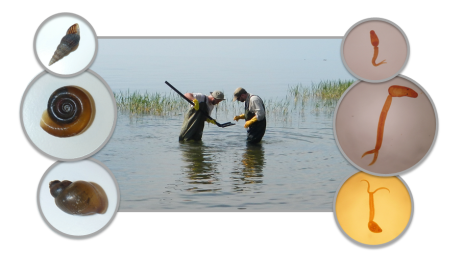By John Archer
Infection with parasitic trematodes, giving rise to debilitating and life-threatening diseases such as schistosomiasis and fascioliasis, affect more than 500 million people and a countless number of other vertebrate hosts globally. For transmission of such diseases to take place, just three simple ingredients are required; the presence of infected freshwater snail intermediate hosts; a suitable aquatic habitat in which they can survive; and repeated human, or animal, water contact with this habitat.
As a postgraduate student at the Liverpool School of Tropical Medicine embarking upon his Masters’ dissertation, I was recently fortunate enough to conduct fieldwork along the shoreline of Lake Albert, Uganda. My project aims to investigate not only freshwater snail population dynamics in this region, but also the human and animal trematode infections they may, or may not, be transmitting; building on recently published work with a similar focus along the same shoreline. In addition, the trip gave an eye-opening and invaluable opportunity to witness and experience first-hand communities so heavily burdened with Neglected Tropical Diseases (or NTDs), that they are an ingrained part of everyday life.
Our research
Freshwater snails collected from aquatic habitats at the lake’s edge were screened on-site for trematode infection using a shedding analysis; a procedure that involves placing snail hosts into individual shedding trays containing bottled drinking water throughout the day (you can imagine my guilt using clean water in this way given the environment we were in). The bottled water is then examined using a dissecting microscope for the presence of shed cercariae; the free-swimming trematode larval stage responsible for human and animal infection.
A variety of different cercariae species were found; each with their own distinctive swimming behaviours and morphologies. Furthermore, staining the cercariae by adding a drop of Lugol’s iodine to the water sample and pipetting it onto a glass slide for observation under a compound microscope allowed for closer morphological analysis, as well as providing a great opportunity to take pictures of our findings.
Above (left): Melanoides, Biomphalaria and Bulinus freshwater snails capable of transmitting trematodes infections. (Middle): Myself and Russell Stothard collecting freshwater snail samples at Lake Albert’s edge. (Right): Three trematode cercariae of different species shed from collected freshwater snails capable of infecting humans, birds and amphibians.
Collecting samples at the lake’s shore across a multitude of villages truly emphasised its significance as a resource essential for both human and animal survival. Whether utilised as a source of drinking water, a place to bathe, an area to catch fish, or just as a means of recreation, one thing was clear; contact with these potentially dangerous waters is currently both completely necessary and patently inevitable.
As such, until enhanced and repeated access to donated treatment, an increased awareness of disease transmission and a reduction in water-contact through means such as improved sanitation are implemented, trematode disease transmission will, undoubtedly, persist in these villages.
The lake’s edge at Butiaba; people interacting with potentially dangerous waters is a common sight.
Looking ahead
Having returned to Liverpool, I’m very much looking forward to the next steps in my project; assessing the population dynamics of both snail hosts and trematodes using GIS mapping and statistical analysis; employing molecular methods to further characterise and quantify snail trematode infection status’ and transmission potentials, as well as visiting and working with world-leading experts in this field at London’s Natural History Museum. Watch this space.




